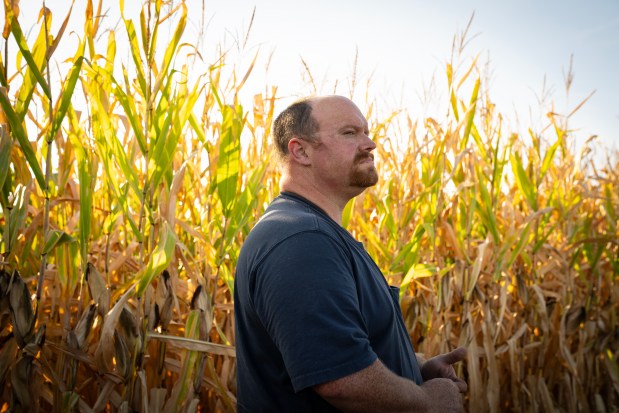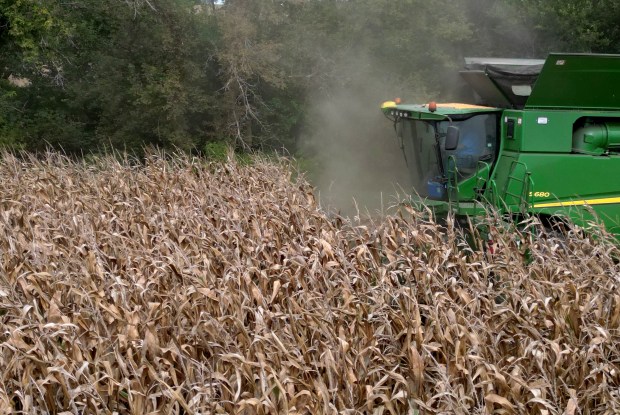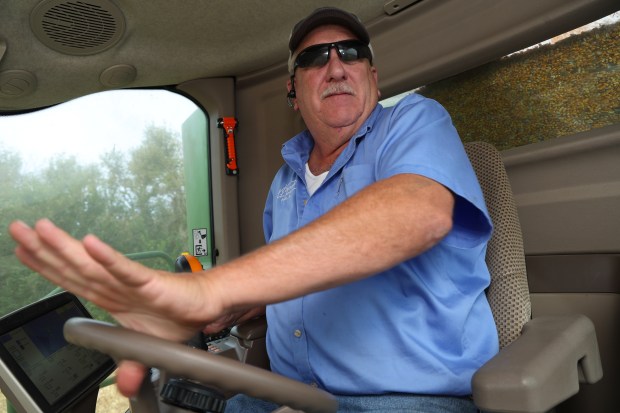Since the last farm bill was enacted in 2018, international wars and a pandemic have disrupted supply chains, inflation has skyrocketed and worsening climate change has put a renewed emphasis on conservation practices.
Farmers feel left behind and forgotten.
“I should be in a good mood. My Illini just won and I had a nice weekend with my family, but to be real honest, I’m frustrated,” Jared Gregg, a seventh-generation farmer from Piatt County, told the Tribune in early September.
The U.S. Department of Agriculture had just called and asked him to complete a survey when he was in the midst of preparing for a busy harvest season. It was another reminder that the federal government is out of touch with farmers, said Gregg.
Yet again, Congress is unlikely to pass an updated farm bill.
The comprehensive package of legislation that sets agriculture and food policy is supposed to be updated every five years. But partisan gridlock got in the way last year, forcing Congress to simply extend the 2018 bill another year. That extension expires Sept. 30 and, with a presidential election less than two months away, Congress isn’t focused on finalizing a new five-year plan. Experts say the lawmakers are likely to extend the 2018 bill again.
“I’d like to see the government put forward as much effort as American farmers are putting forward,” Gregg said. “Watching them play politics is a tough pill to swallow when prices are down and expenses are up.”
Consumer grocery prices rose 25% between 2019 and 2023 and have continued to rise, but this hasn’t translated to extra income for farmers. The price hikes are getting tacked on due to supply chain issues between the farm and the store shelves.
Like all Americans, though, farmers’ expenses from labor to equipment and fertilizer are rising.
“Who wants to live in an income world based in 2018 with an expense world based in 2024? That’s the world we’re chained to without an updated farm bill,” said Illinois Farm Bureau President Brian Duncan.
In the extremely unlikely event that Congress doesn’t extend the 2018 farm bill by the end of the year, a permanent New Deal-era law that the temporary farm bill overrides would kick in, leaving farmers to operate with even more outdated legislation.
Rural economies in Illinois, the No. 1 producer of soybeans and the No. 2 producer of corn in the country, would be hard-hit. The state’s agricultural industry supports nearly 2 million jobs and more than $462 billion in economic output, according to House Agricultural Committee Communication Director Ben Goldey.
Jonathan Coppess, an agriculture policy expert at the University of Illinois at Urbana-Champaign, is particularly worried that programs incentivizing sustainable farming could flounder without a new farm bill. Approximately 40% of valid Illinois applications already go unfunded, according to a letter a Democratic delegation of Illinois lawmakers sent the U.S. Department of Agriculture in August.
“We’re limiting the amount of funds available for farmers to do conservation, then we’re expanding what we want them to do under conservation umbrellas,” he said, citing growing attention to the role poor agricultural practices play in the climate crisis and biodiversity loss.
Even in 2018, the farm bill funding available for conservation programs didn’t meet the demand. The 2022 Inflation Reduction Act infused nearly $20 billion over five years into these programs. But the backlog has persisted. Inflation has only exacerbated the problem.
Both the Democratic and Republican farm bill proposals bolster conservation programs, but the Republican version eliminates the programs’ focus on reducing carbon emissions and sequestering carbon, a caveat the Democrats injected alongside the extra IRA Inflation Reduction Act funding.
Illinois has particularly struggled to secure conservation dollars in the current funding landscape. It has the fourth most cropland of any state but, from 2018 to 2022, received less conservation funding than 36 other states, according to the delegation of Illinois lawmakers.
Meanwhile, the lawmakers estimate that only 4% of Illinois’ 22 million acres of cropland have employed conservation practices, a dismal number they attribute to “uniform, inflexible ‘standards” for funding that are biased against the cropping practices, weather and terrain in Illinois.
The delegation, which included Sens. Tammy Duckworth and Dick Durbin, urged the U.S. Department of Agriculture to double or triple the nationwide conservation funding allocated to Illinois.

Gregg has two outstanding applications to experiment with pesticide mitigation strategies and to grow cover crops, both of which are proven to improve soil quality, reduce nutrient runoff that causes harmful algae blooms and foster pollinator habitats.
He’s motivated by the possibility of tapping into new clean energy markets such as sustainable aviation fuel. The federal government opened the door for jet fuel to be made from corn that meets particular sustainability standards earlier this year.
“If they expect me to produce in a conservation-minded fashion, I’m holding up my end of the bargain. But, I’m not seeing it happen on their end,” said Gregg, who poured hours into conservation plans for his farm.
He doesn’t have the wiggle room in his budget to adopt the necessary sustainable practices without government assistance. The market price for corn and soybeans has declined 15% and 25% respectively since last summer. Meanwhile, Gregg anticipates next year’s expenses to be about 30% higher than their five-year average.
Coppess, the University of Illinois professor, fears many farmers will become discouraged from adopting conservation practices if their applications keep getting denied. Fewer applications could result in even less funding, creating a counterproductive cycle that could kill the current enthusiasm around conservation-minded farming.
For farmers who have been lucky enough to secure it, the funding has been transformative.
“I would have never built our high tunnel (structures that reduce nutrient loss and improve soil quality) or been able to put in our pollinator strips without funding. It would have been a huge risk for me to take,” said Ed Dubrick, a first-generation poultry farmer in Cissna Park.
Americans nationwide stand to benefit from the widespread adoption of conservation practices on farms, according to Coppess.
Cover crops reduce nutrient runoff that contaminates local drinking water and then travels down to the Gulf of Mexico where it threatens the Cajun seafood industry. No-till farming keeps soil in place, mitigating the risk of deadly dust storms like the one on Interstate 55 last summer. Pollinator strips increase biodiversity.

“Conservation is like the bridge between farmers and nonfarmers because it’s where we pay farmers to do things that help them and the rest of us,” said Coppess.
The farm bill expires Monday evening but funds won’t peter out until early next year. House Agriculture Committee Chairman GT Thompson is committed to working through the October recess to pass a farm bill before then, said Goldey.
If the lawmakers can’t reach a compromise, Coppess offers a counterintuitive but pragmatic solution to the outdated bill: Instead of getting into a pattern of making one-year extensions year after year, lawmakers should extend the current farm bill for two years. This gives the incoming Congress a more realistic time frame within which to negotiate and reach a consensus.
Farmers are already pessimistic about the prospects of a new farm bill this year anyway.
“Hope is all we can do,” said Duncan, the Illinois Farm Bureau president. “We tighten the belt, defer capital expenditures, be as efficient as possible on current expenses and hope things get better. At least here in Illinois, it looks like we’re going to have a good crop year.”





